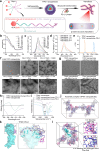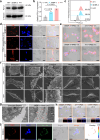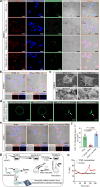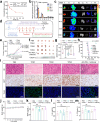In situ editing of tumour cell membranes induces aggregation and capture of PD-L1 membrane proteins for enhanced cancer immunotherapy
- PMID: 39521768
- PMCID: PMC11550832
- DOI: 10.1038/s41467-024-54081-9
In situ editing of tumour cell membranes induces aggregation and capture of PD-L1 membrane proteins for enhanced cancer immunotherapy
Abstract
Immune checkpoint blockade (ICB) therapy has emerged as a new therapeutic paradigm for a variety of advanced cancers, but wide clinical application is hindered by low response rate. Here we use a peptide-based, biomimetic, self-assembly strategy to generate a nanoparticle, TPM1, for binding PD-L1 on tumour cell surface. Upon binding with PD-L1, TPM1 transforms into fibrillar networks in situ to facilitate the aggregation of both bound and unbound PD-L1, thereby resulting in the blockade of the PD-1/PD-L1 pathway. Characterizations of TPM1 manifest a prolonged retention in tumour ( > 7 days) and anti-cancer effects associated with reinvigorating CD8+ T cells in multiple mice tumour models. Our results thus hint TPM1 as a potential strategy for enhancing the ICB efficacy.
© 2024. The Author(s).
Conflict of interest statement
All authors declare no competing interests.
Figures







Similar articles
-
Blocking of the PD-1/PD-L1 interaction by a novel cyclic peptide inhibitor for cancer immunotherapy.Sci China Life Sci. 2021 Apr;64(4):548-562. doi: 10.1007/s11427-020-1740-8. Epub 2020 Jul 28. Sci China Life Sci. 2021. PMID: 32737851
-
Nanomicelle protects the immune activation effects of Paclitaxel and sensitizes tumors to anti-PD-1 Immunotherapy.Theranostics. 2020 Jul 9;10(18):8382-8399. doi: 10.7150/thno.45391. eCollection 2020. Theranostics. 2020. PMID: 32724476 Free PMC article.
-
Nanomotors activating both cGAS-STING pathway and immune checkpoint blockade for tumor therapy and bioimaging.Talanta. 2025 Mar 1;284:127258. doi: 10.1016/j.talanta.2024.127258. Epub 2024 Nov 20. Talanta. 2025. PMID: 39586211
-
Targeting novel regulated cell death: Ferroptosis, pyroptosis and necroptosis in anti-PD-1/PD-L1 cancer immunotherapy.Cell Prolif. 2024 Aug;57(8):e13644. doi: 10.1111/cpr.13644. Epub 2024 Apr 9. Cell Prolif. 2024. PMID: 38594879 Free PMC article. Review.
-
Modulation of N-glycosylation in the PD-1: PD-L1 axis as a strategy to enhance cancer immunotherapies.Biochim Biophys Acta Rev Cancer. 2025 Apr;1880(2):189274. doi: 10.1016/j.bbcan.2025.189274. Epub 2025 Jan 26. Biochim Biophys Acta Rev Cancer. 2025. PMID: 39875060 Review.
Cited by
-
Systematic Comparison of Commercial Uranyl-Alternative Stains for Negative- and Positive-Staining Transmission Electron Microscopy of Organic Specimens.Adv Healthc Mater. 2025 Jun;14(16):e2404870. doi: 10.1002/adhm.202404870. Epub 2025 Apr 29. Adv Healthc Mater. 2025. PMID: 40302369 Free PMC article.
-
Modulating tumor collagen fiber alignment for enhanced lung cancer immunotherapy via inhaled RNA.Nat Commun. 2025 Aug 30;16(1):8120. doi: 10.1038/s41467-025-63415-0. Nat Commun. 2025. PMID: 40885724 Free PMC article.
References
-
- Konishi, J. et al. B7-H1 expression on non-small cell lung cancer cells and its relationship with tumour-infiltrating lymphocytes and their PD-1 expression. Clin. Cancer Res.10, 5094–5100 (2004). - PubMed
-
- Dong, H., Zhu, G., Tamada, K. & Chen, L. B7-H1, a third member of the B7 family, co-stimulates T-cell proliferation and interleukin-10 secretion. Nat. Med.5, 1365–1369 (1999). - PubMed
Publication types
MeSH terms
Substances
LinkOut - more resources
Full Text Sources
Research Materials
Miscellaneous

